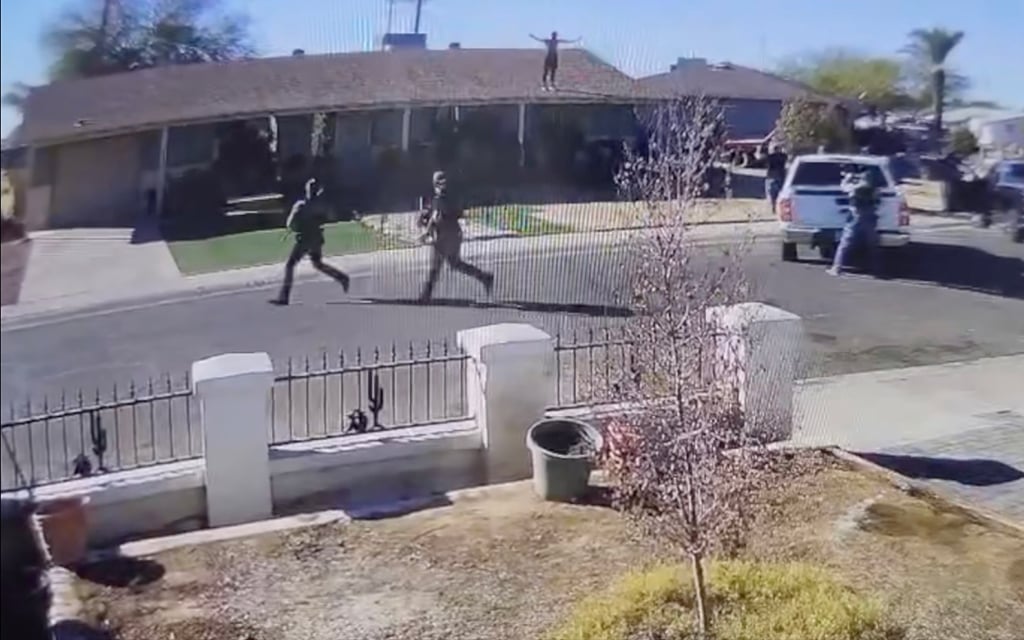
An image taken from a bystander’s video shows that an unarmed Turrell Clay raised his arms before Phoenix officers shot projectiles at him on Jan. 10, 2025. In the video, Clay has his arms up for over a minute before he is shot at the edge of the roof. An officer’s body camera and police drone also recorded this moment, but Phoenix police edited out this footage from its video briefing. (Photo from bystander video)
PHOENIX — Turrell Clay lived out the painful last afternoon of his short life in broad daylight, under a wintry desert sun.
When he stripped off his shirt and climbed atop a Maryvale home, baring his chest to a swarm of Phoenix police officers, their body cameras clearly captured the unfolding violence.
The footage they recorded on Jan. 10 constitutes the official video record captured by police of what happened to the 33-year-old Black man in the tense minutes that came after a police pursuit and preceded Clay’s death.
Two weeks later, the Police Department edited the footage together and released it to the public in an official video intended “to present a factual picture of what happened.”
Body-camera and drone footage shows that officers used launchers to fire painful, 4-inch long projectiles at Clay’s body. They stopped just before he dropped to the ground, screaming and writhing.
(Video by L. M. Boyd and Alessandra De Zubeldia/Howard Center for Investigative Journalism at ASU)
But extended police video obtained by the Howard Center showed what the department left out of the briefing: Clay stood high on the roof and raised his arms.
“Turrell, walk toward me,” an officer yelled to Clay, who started moving slowly to the edge of the roof with his hands still raised.
For a moment, the throng of officers below kept their weapons pointed at him.
“Keep your hands up where I can see … if you don’t wanna die,” the officer continued to command Clay. “Keep walking toward me.”
Clay kept walking until he reached the front edge of the roof, where he sat facing officers with his arms raised. By then, his hands had been visible for a minute and a half.
Then, the officer with the launcher fired. The projectile knocked Clay on his back, and he rolled and wailed in pain.
Around 20 seconds later, the officer fired a final time, and Clay slid from the roof and onto the ground.
Clay’s family is seeking $15 million from the city of Phoenix for wrongful death, according to a notice of claim obtained by the Howard Center.
While the Phoenix Police Department bills itself as a body-camera trailblazer, the Howard Center discovered selectively released footage and switched-off cameras don’t always give the public a full picture of what happens when officers injure, shoot or kill civilians.
As a result, critical moments of police encounters often go unseen and unheard — buried in body-camera footage whose release the department controls.
The primary way Phoenix police publicly releases footage from officers’ body cameras is through edited video narratives — called Critical Incident Briefings. Since October 2019, the department has produced these video briefings to explain the lead-up and details of police shootings and other encounters where officers killed or seriously hurt civilians.
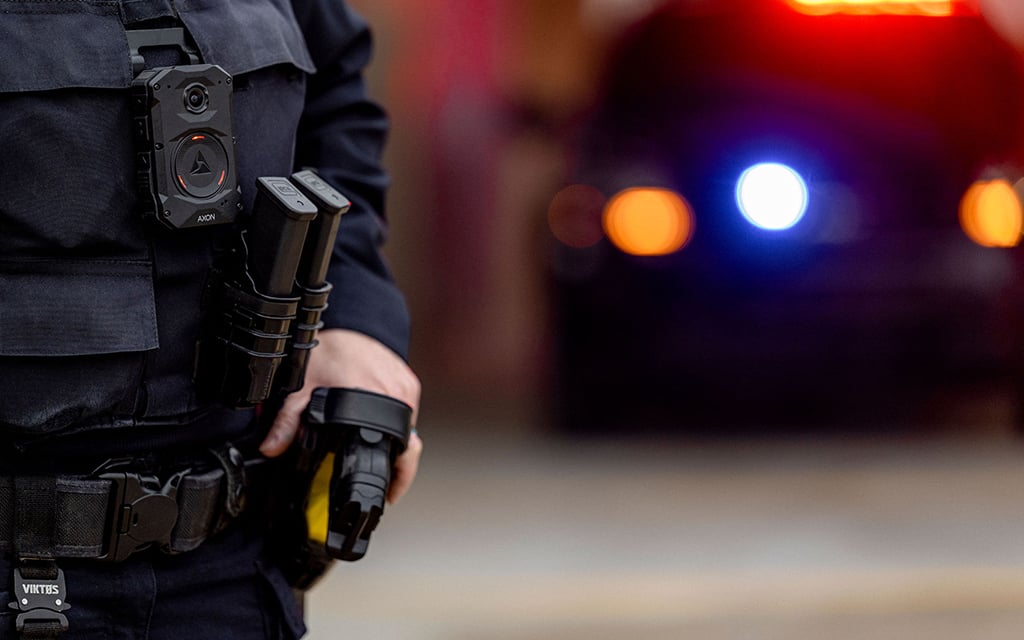
Phoenix police often releases snippets of body-camera footage within two weeks of a violent police encounter through video briefings. In its response to the Department of Justice’s investigation into constitutional violations, the department heralded these video briefings as one of its recent “major reforms” and a model that other law-enforcement agencies were interested in adopting. (Photo courtesy of Axon)
Department guidelines direct that these video briefings “will consist of available and relevant video and audio footage” that depicts the “most potentially controversial encounters with civilians,” including edited body-camera footage, 911 call audio and video captured by third parties.
They have served as a centerpiece of Phoenix police’s accountability policy. Last year, the agency touted the videos as a testament to its transparency amid the Biden-era Department of Justice investigation accusing it of using excessive force.
In May, the DOJ under the Trump administration retracted the department’s investigation into the Phoenix Police Department and retracted or closed investigations into five others. The department also moved to dismiss lawsuits against Louisville and Minneapolis.
The Phoenix Police Department’s video about Clay’s death was one of 95 video briefings that the Howard Center analyzed to understand how the department edits body-camera footage and publicly depicts deadly or violent encounters between police and civilians.
While Phoenix police began publishing these videos in 2019, the Howard Center’s data analysis began with 2021, when Phoenix police started publicly tracking data on whether an officer had activated the body camera in a violent encounter.
The Howard Center also obtained uncut body-camera footage in nine cases from 2020 to 2024 and compared that footage to the edited video briefings of those cases.
The Howard Center’s analysis found:
Delayed medical aid — The department edited out footage of officers failing to provide critical medical aid to civilians for two to 10 minutes after shooting them in six of the nine video briefings for which the Howard Center obtained uncut footage.
Unseen violence — The department did not show footage of officers using less-lethal force against civilians in about one in every eight video briefings analyzed from 2021 to January 2025.
Silent footage — The department placed narration by its spokespeople over body-camera footage, muting or drowning out audio as violent police encounters unfolded in four out of every 10 video briefings. Nearly 30% of the video briefings also featured stretches of silent footage because officers failed to activate their body cameras before they arrived on scene.
Switched-off cameras — A Phoenix officer did not activate their body camera in one out of every 25 interactions where they injured or killed civilians since 2021, according to a Howard Center analysis of department use-of-force data. With limited exceptions, department policy requires officers to activate body cameras before “any investigative or enforcement contact.”
The department ruled that officers violated its policies in just seven of the 348 violent interactions with civilians during which officers hadn’t activated their body cameras between 2021 and January 2025. It’s unclear from the data whether the violations broke body-camera policy or another departmental standard.
Because Phoenix police does not routinely release uncut, raw body-camera footage alongside its video briefings, the Howard Center could not tell what was left out of every incident briefing.
But the omissions the Howard Center found in the briefings compared to the unedited footage raise questions about the completeness of the rest.
“It is the Department’s goal, as part of our transparency commitment to our community, to release these videos, and correlative materials, within 14 days of a critical incident,” Phoenix police wrote in a statement to the Howard Center.
The department did not answer a question about critical incident videos that did not show officers rendering medical aid, but said the videos were intended to depict “the actions and events leading up to and including a critical incident.”
The video briefings “have evolved over the years after input from work groups which included victim advocates, the public and surviving family members of loved ones involved in critical incidents with police,” the statement said.
Activists, policing experts, lawyers, civilians and their loved ones have expressed that the edited footage often leaves the public with more questions than answers, enabling the department to shape the narrative the public sees.
“All those things undermine any sort of transparency that those videos might otherwise have,” said Jared Keenan, legal director of the American Civil Liberties Union of Arizona, about the ways in which Phoenix police edits body-camera footage in video briefings.
“All these pieces together make what could be a pretty strong tool for accountability and transparency into something that has provided very little accountability and transparency.”
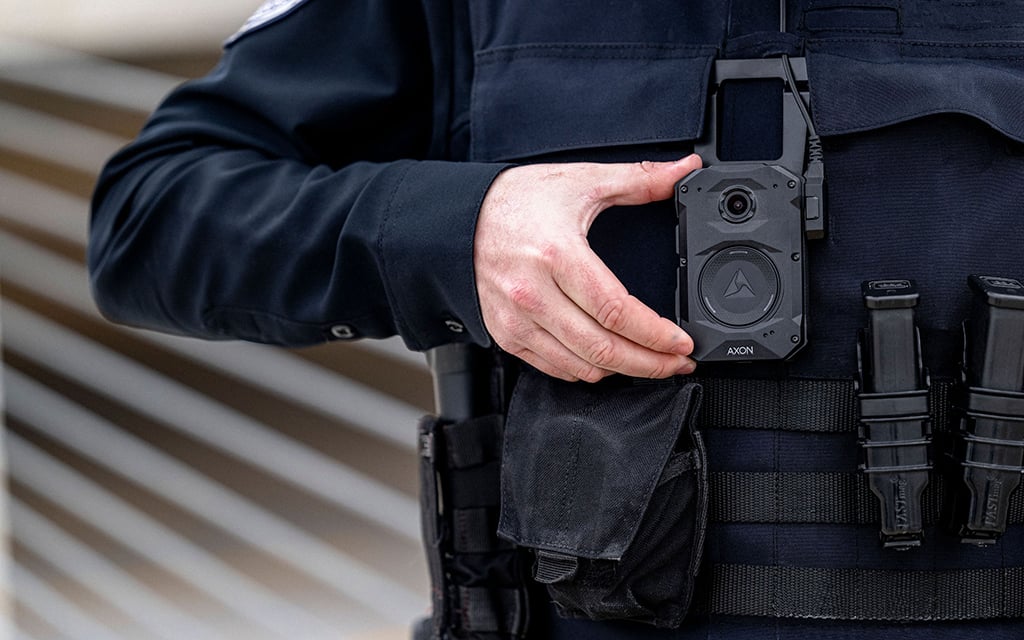
The Howard Center found that officers did not activate their body cameras in one of every 25 interactions where they injured or killed civilians from 2021 to January 2025. (Photo courtesy of Axon)
Transparency crisis prompts camera use
When the department deployed body cameras to all patrol officers in 2019, it was a decision born from a crisis of transparency. People across the nation were outraged by a viral phone video earlier that year that showed Phoenix police officers pointing their guns at a Black family and threatening to shoot the father after his 4-year-old daughter took a doll from a dollar store.
Like most Phoenix police officers at the time, they weren’t wearing body cameras.
Phoenix police were a nationwide trailblazer for its experiments with body cameras back in 2011. Two years later, in 2013, the department’s Police Body Worn Camera Program made it one of the first major police departments in the country to deploy what was then a promising technology for revolutionizing police transparency.
Yet in 2019, the public was coming to view them in a starkly different light. Phoenix Mayor Kate Gallego and then-Police Chief Jeri Williams listened to the calls for reform. By the end of the summer, every patrol and enforcement officer had a body camera clipped to their uniform.
The department’s website states this program was created “in support of the department’s commitment to reducing crime and strengthening the relationships between the police and the community.” Today, over 2,000 body-worn cameras are deployed to Phoenix police personnel.
This body-camera coverage is a point of pride for the department, which called itself a “leader in the national conversation on how to use body worn cameras effectively” in a preemptive response to the DOJ’s investigation into potential violations of constitutional rights.
Within some legal limits, Phoenix police wields control over if and when uncut footage will be released. The department rarely releases uncut body-camera footage of encounters where police injured or killed civilians to the public alongside video briefings.
The Howard Center requested extended body-camera footage of Clay’s arrest in March, but the department said it would not be available for two to three years. The Arizona Republic published a story May 13 that included extended body-camera footage of Clay’s arrest. The Howard Center re-requested the footage from the department and obtained it three days later.
If the department doesn’t preemptively release uncut footage to the public or the media, the only way people in the community can access it is by filing requests to the department under Arizona’s public records law. Department policy, however, bars “citizens” from reviewing footage unless they have “an investigative reason.”
And because the department lacks a ceiling on how long it can take to release raw footage, it can sometimes take years to fulfill these requests. A Phoenix police records employee working on a request for video from the Howard Center said the process was “four years backlogged.”
In its statement, the department said one of the three squads in its Body Worn Camera Unit is dedicated exclusively to working on public records requests.
The Body Worn Camera Unit “is always seeking ways to improve our processes and respond to public records requests in a reasonable manner that complies with the law,” the statement said.
When asked how Phoenix police should release body-camera footage to the public, Gregg Leslie, the executive director of the First Amendment Clinic at the law school at Arizona State University, argued in favor of simply releasing raw footage of incidents.
“Anything else that looks edited, looks like you’re hiding part of the story,” he said.
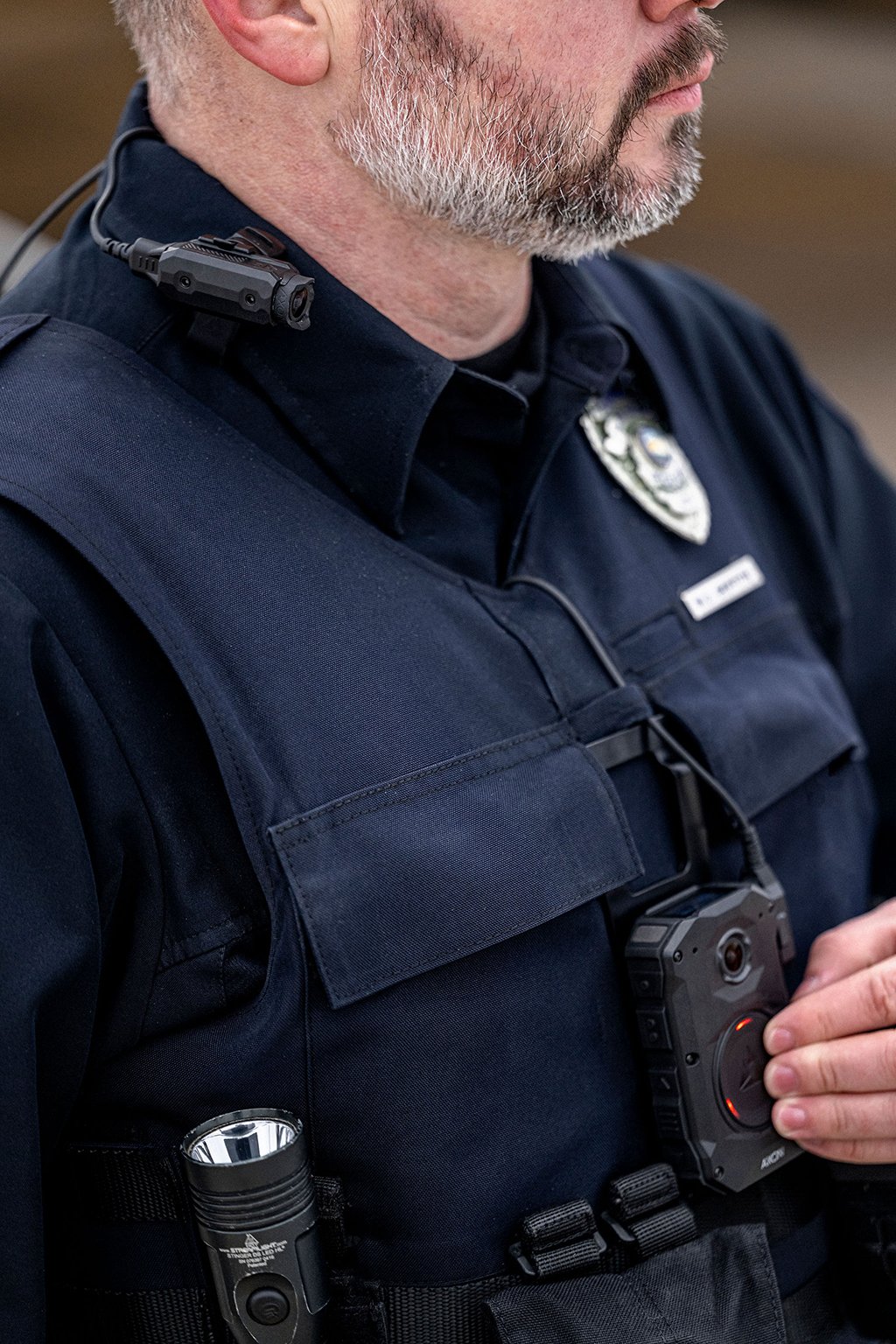
Officers activate body cameras by depressing a button on the camera’s front, as shown in a photo from Scottsdale-based manufacturer Axon. The devices are designed to save some footage just before activation — although without audio. Since 2021, Phoenix police has extended this pre-activation window to 90 seconds. While cameras capture more video, officers who fail to to activate their cameras before encounters with civilians will still result in longer stretches of footage without the audio. (Photo courtesy of Axon)
‘I’m gonna die’
Ethan Fuller began the dark, early morning hours of March 8, 2023, thinking that day would mark the beginning of his new life, he later wrote in court.
Instead, the 27-year-old was actually lost in schizophrenic psychosis. His memory went dark when a Phoenix officer shot him in the neck at close range at a bus terminal in Maryvale.
Dressed in khakis and a blue blazer, the Indiana native wandered the terminal lounge and parking lot. He was hallucinating that he was reliving the sexual abuse he endured for years as a child, but from the perspective of his abuser.
The massage therapist had driven from his home in Sedona, intent on fleeing the false accusations his mind threw at him. He ended up in Maryvale, where the delusions followed. So, he entered a crowded bus terminal, yelling and telling a worker to call the police so he could turn himself in.
That was how Fuller met Officer Zachary Wheeler.
The Phoenix police video briefing of Fuller’s encounter with police included snippets from Wheeler’s body-camera and surveillance footage from the bus station.
In the video briefing, Wheeler took Fuller outside and asked him, “So, what’s going on?”
Swaying back and forth, Fuller began to open up to Wheeler in a soft voice.
Then the officer interrupted him: “Stop going closer to me.”
The video showed Fuller pushed Wheeler. Wheeler tased him. Then, Fuller kicked and lunged at the officer, knocking the taser to the ground. Wheeler drew his handgun and shot Fuller twice.
The encounter lasted about a minute.
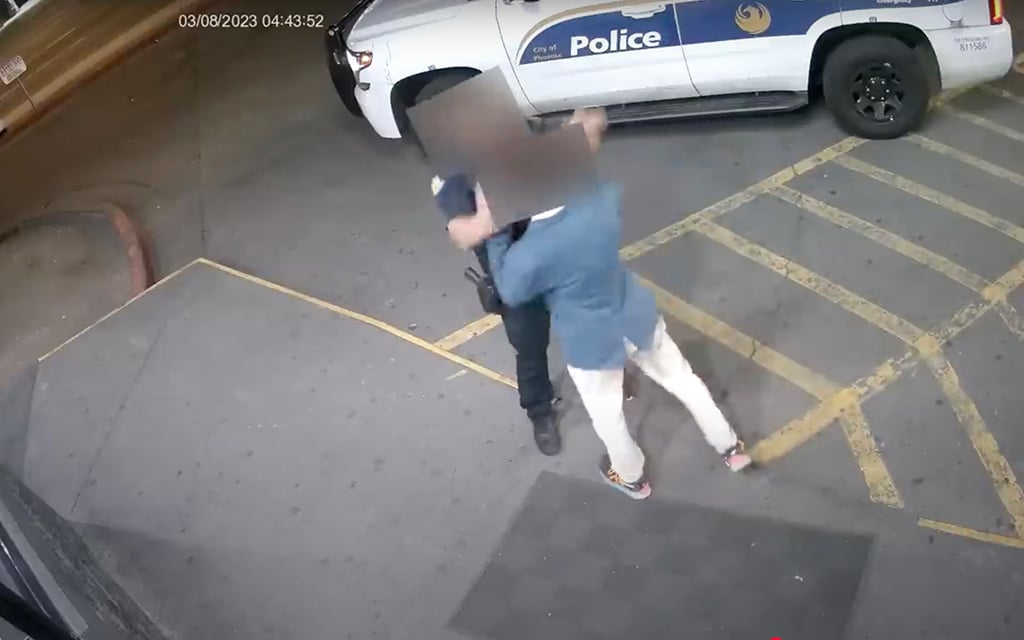
Surveillance footage featured in Phoenix police’s video briefing showed that Ethan Fuller pushed Officer Zachary Wheeler, which prompted the officer to tase and then physically struggle with Fuller, before shooting Fuller twice. The video briefing also shows footage of the encounter from Wheeler’s body camera. (Photo courtesy of Phoenix Police Department)
The last shot of body-camera footage in the video briefing shows Fuller falling to the ground like a log after he was shot. But the department edited out the minutes that followed, captured in uncut body-camera video obtained by the Howard Center.
For two minutes, officers towered over Fuller’s prone body, shouting commands at him instead of giving critical aid.
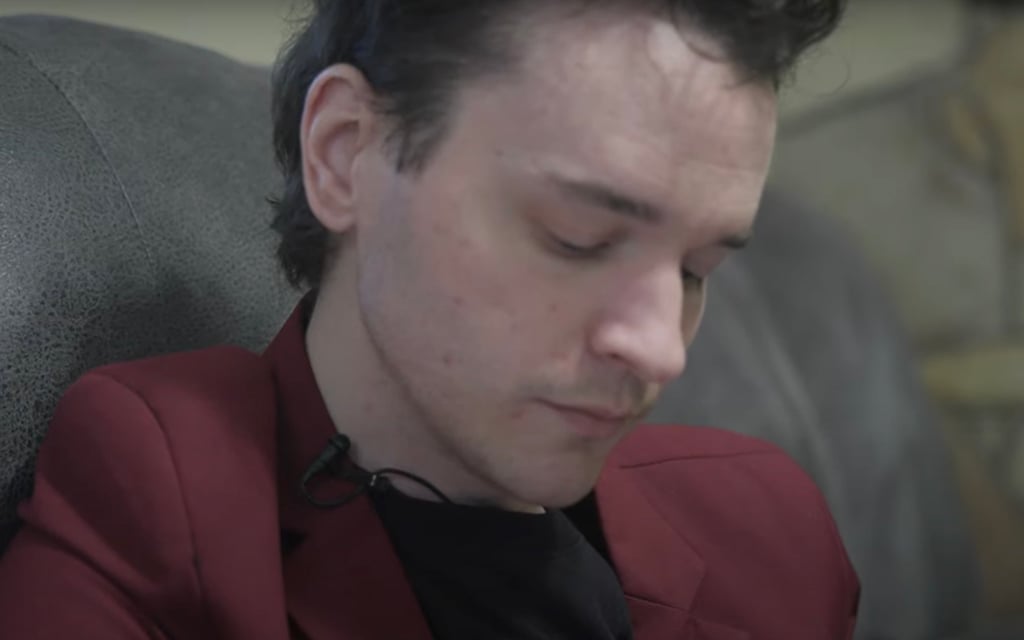
Ethan Fuller watches Phoenix police’s video briefing detailing the police shooting he survived two years before from his home in Indiana on March 30, 2025. “Next thing you know, I’m on the ground, shot,” Fuller told the Howard Center after watching the video. “It’s very fast.” (Photo by Lillian Boyd/Cronkite News and the Howard Center for Investigative Journalism at ASU)
“You can just see the after-treatment of me on the ground by the police and me struggling to breathe and get into a comfortable position. Meanwhile, they’re yelling at me to try to stay still,” Fuller told the Howard Center.
The blood from Fuller’s wounds pooled around him, the red staining his neck, chest and the ground below.
Fuller didn’t wake up until 10 days later.
The video briefing never showed footage of Wheeler or paramedics giving Fuller medical attention. Instead, department spokesperson Melissa Soliz narrated that officers and firefighters treated Fuller at the scene until he was brought to a hospital.
(Video courtesy of Phoenix Police Department)
The Howard Center reviewed five other video briefings in which the department did not include body-camera footage showing that officers delayed giving civilians medical attention after shooting them.
Instead, uncut footage revealed a range of actions: some officers stood back, others shouted commands or continued to fire weapons at civilians’ prone bodies for two to 10 minutes after shooting at them.
Sometimes, the gunshot wounds had knocked civilians into dead silence. Other times, they were screaming out: “I’m gonna die.”
Officers may have delayed aid for longer than 10 minutes in some cases, but the body-camera footage cut off or the officer with the body camera stepped away from the scene before police gave medical aid in some of the videos obtained by the Howard Center.
Phoenix police policy requires that officers are “responsible” for requesting and rendering medical attention to injured civilians “as soon as practical.” The rule emphasizes that officers value the “sanctity of human life” and “make every reasonable effort to preserve human life in all situations.”
However, the DOJ found that Phoenix police delayed or failed to render aid in multiple instances, resulting in death in at least one case.
The family of Juan Reynoso is currently suing the city of Phoenix over this issue. The 26-year-old’s family says the city should have to admit that officers “breached the standard of care by failing to administer, or adequately and/or timely administer, aid” after shooting and killing the father of four in front of his wife, teenage sister and young daughters in 2023, according to court documents.
The officers and the city of Phoenix have yet to respond to the family’s claims in court.
The damages sought by Reynoso’s family may add to the tens of millions in taxpayer money that the Phoenix City Council has paid to settle hundreds of misconduct claims against the Police Department over the last 25 years.
Since 2023, the department has not included body-camera footage of officers, paramedics or firefighters providing medical attention to those shot in video briefings, rendering it impossible to tell from those videos alone whether officers delayed life-saving aid.
What happened after Clay’s arrest in January — and hours before his death — is not shown in the video briefing regarding his encounter with Phoenix police.
The official video ends with department spokesperson Phil Krynsky briefly explaining that, after officers called paramedics to evaluate Clay, he told police he was “having a hard time breathing.” Officers then brought Clay to a hospital, and he ultimately received what Krynsky called “advanced medical care.”
Police records obtained by the Howard Center revealed that Clay suffered a heart attack. He died later that evening, four and a half hours after his first encounter with police. The department’s video briefing didn’t show any footage of Clay receiving medical aid from paramedics.
Extended body-camera footage taken after the paramedics left and obtained by the Howard Center showed that Clay was breathing heavily, slurring words and acting disoriented while sitting in a police cruiser.
“My chest hurts so bad,” Clay told officers as they prepared to take him in for booking.
Not all force shown
In some cases, the Howard Center found the Police Department obscured key moments of violent police encounters.
When comparing uncut body-camera footage to the video briefing in another case, the Howard Center found Phoenix police edited out some of the violence itself. In the deadly 2021 encounter between Anthony Greco and officers, the department cut footage where officers used less-lethal force against him. The DOJ said the use of less-lethal force in this case might have violated the Fourth Amendment.
In the video briefing, body-camera footage showed that Officer Warren Jackson shot the 29-year-old after he broke into a woman’s house with a gun. But the public didn’t see footage of what happened right after.
Instead, a department spokesperson explained that officers used commands and less-lethal bean-bag rounds — painful lead-filled sacks fired from shotguns — for several minutes against the man, “due to the proximity of Greco from his gun.”
The video then cut to footage showing officers firing two bean-bag rounds at Greco’s body.
The police department did not include footage from when Lt. Joseph Gage commanded Officers Dustin Haynes and Jeremy Pyles to fire six other beanbag rounds at Greco’s unmoving body over less than three minutes, described in the department’s internal shooting review sent to then-Interim Chief Michael Sullivan. Following the barrage, Gage stopped to take a phone call.
Officers didn’t approach Greco to give him CPR until nearly 10 minutes after he was shot with lethal force. By then, Greco’s heart had already stopped, according to the DOJ report.
He was pronounced dead at the scene.
‘Public doesn’t get a true picture’
David Bodney, a First Amendment lawyer who served on the Law Enforcement Officer Body Camera Study Committee — a state legislative group that considered future recommendations for Arizona body-camera law — witnessed Phoenix police embrace body cameras. He said he saw the extent to which law enforcement officers valued the cameras as an opportunity to “demonstrate that they were practicing sound law enforcement techniques.”
But, he said that in his experience, the way body cameras and the release of their footage have been implemented into department policy reflect little of the promise touted years ago.
“As I look at the policy and reflect on my experience endeavoring to secure access to body-worn camera footage, there’s a wide gap between the claimed benefits and the actual benefits to the public,” Bodney said.
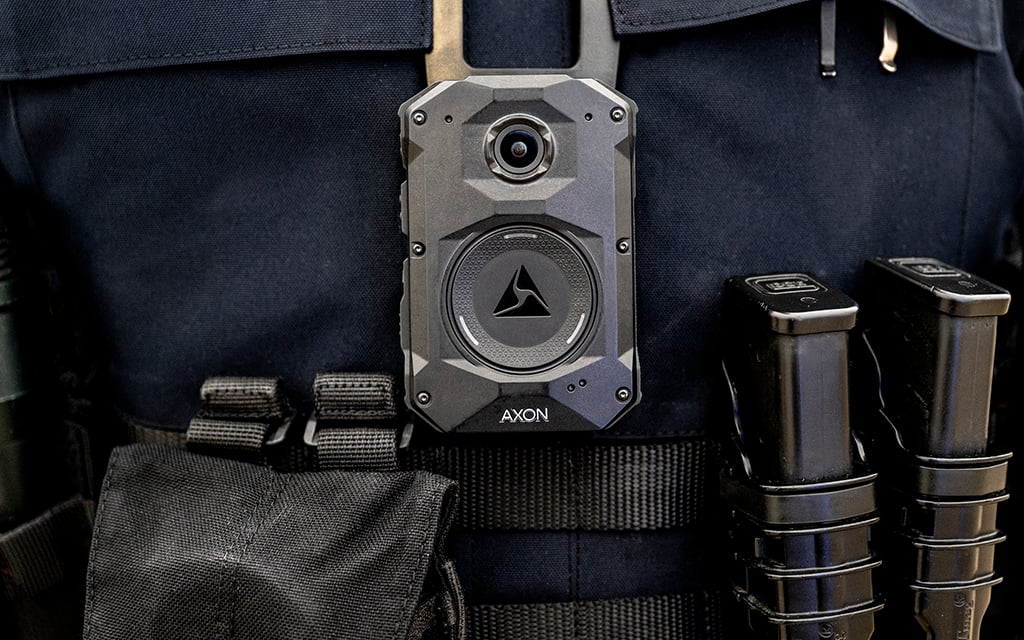
Before Phoenix police widely deployed body cameras in 2019, Phoenix was the largest city in the country that hadn’t outfitted most officers with the technology. Since then, body cameras have been a costly investment for the city, which has committed nearly $47.5 million for thousands of body cameras through 2028 for the sake of transparency. (Photo courtesy of Axon)
Even for those shot, killed or injured by police, it often takes years to receive the raw footage of an incident, undermining their ability to file civil litigation and, in some cases, even a right to a fair trial, the ACLU’s Keenan said.
Without the full footage, “the public doesn’t get a true picture of what’s happening,” Keenan said. And often, neither do the “family members who lost a loved one to police violence and don’t have the answers to what actually happened.”
Leslie, the First Amendment Clinic director, said instances of police delaying medical aid make the case for releasing raw body-camera footage.
“They (police) want to show what happened, so they’re saying, ‘We’re just skipping the places where nothing happened,’” Leslie said. “But that’s a perfect example of where two minutes of ‘nothing happening’ can be a big part of the story.”
Sometimes, the footage doesn’t even exist, leaving families completely in the dark. The same department policy that requires officers to activate their body cameras before any “investigative or enforcement contact” also gives officers discretion to deviate from it “if it is in the best interest of the Department and they are able to justify the deviation.”
“That could be the exception that swallows the rule when it comes to some of the most important footage,” Bodney said — when it comes to body-worn cameras,“the devil is in the details.”
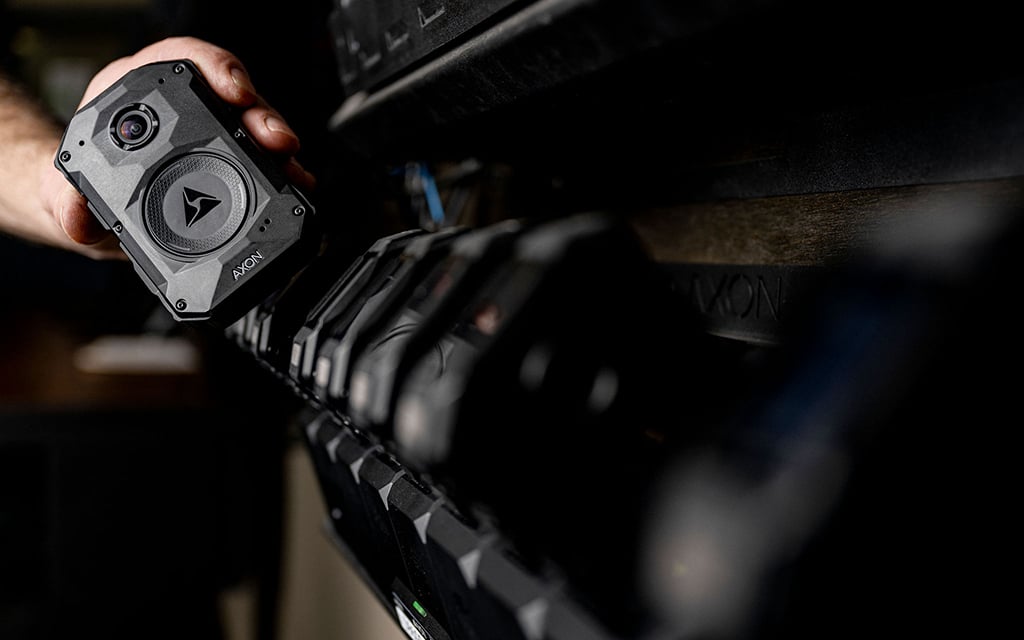
Phoenix police has a dedicated Body Worn Camera Unit responsible for managing and releasing the hours of footage captured by officers’ body cameras to the public. The unit is currently “four years backlogged” in responding to public records requests for video, according to a police employee responding to a Howard Center request for footage. (Photo courtesy of Axon)
Switched-off cameras
Only once has Susan Vespoli watched the video briefing chronicling the dawn of a day in March 2022 when a Phoenix police officer shot a bullet into her 39-year-old son’s head. She said she never intends to watch the “slanted” video briefing again.
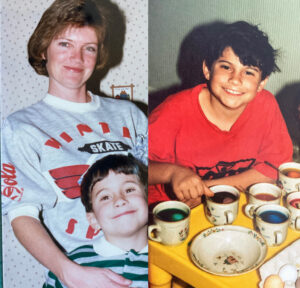
Left: Susan Vespoli holds Adam Vespoli in a family photo from 1989. (Photo courtesy of Susan Vespoli) Right: A young Adam Vespoli paints easter eggs. (Photo courtesy of Susan Vespoli)
But since Adam was killed, the writer has relived her son’s death in poetry dozens of times to seek closure to her grief and trauma.
Those poems have since evolved into a book dedicated to Adam, called “One of Them Was Mine.” The poems, including one titled “Watching 17 Seconds of Video,” chronicle the lasting impressions of the grainy clip depicting her son’s death.
Vespoli described body cameras as an officer’s “external conscience” — a tool that serves as a check on their behavior. The knowledge of being watched, she suggested, can shape how they respond in the moment.
But Officer Donnell Lindo wasn’t wearing a body camera when he shot Vespoli’s son. Lindo’s body camera reportedly fell off his uniform just before the shooting, according to police records.
As of Feb. 19, the Howard Center identified 355 violent interactions with civilians where officers hadn’t activated their body cameras since 2021.
The only video of Adam’s shooting in the department’s video briefing was footage from an overhead surveillance camera. It showed Adam walking from a city bus into the driver’s seat of Lindo’s police car, which the officer had left unlocked and running. Lindo had just commanded Adam and another man to leave the bus after a 911 call reported the men were sleeping on the bus after being asked to exit.
Adam was homeless, so Vespoli said he sometimes slept in public areas. He was also experiencing withdrawals from a heroin addiction that began when he was prescribed pain medicine for a back injury, she said.
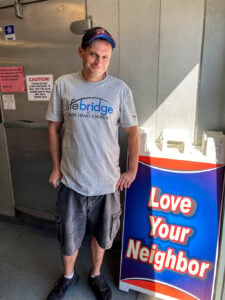
Adam Vespoli working at his church’s food bank. After struggling with addiction, he found support in Pure Heart Church. (Photo courtesy of Susan Vespoli)
In less than 20 seconds, the bus-surveillance video showed Lindo jumping onto the car’s running board and extending his gun through the open driver’s side window. Then four fatal sounds pierce the early-morning quiet: the screech of Adam driving the Chevy Tahoe away and three pops from Lindo’s gun.
That was the same video lawyers Thomas Burke and Evan Goldstein watched to determine how to get Lindo and the City of Phoenix to admit fault in Adam’s death in a now-settled 2023 lawsuit filed by Adam’s parents. Lindo asserted in court and to detectives that he commanded Adam to stop or “get the f— out of my car” before he shot Adam. That was also what detectives investigating the shooting were told in a briefing.
Lindo’s attorneys did not respond to numerous requests for comment.
In police records, the officer told detectives he shot Adam only because he “felt his life was in danger.” He was afraid Adam could run him over with his police car or grab his weapons that were inside.
Whether Lindo’s allegations are true is something Vespoli still questions. Without body-camera footage, Goldstein — her lawyer — says it’s impossible to know for sure.
Burke said, “Really, he (Lindo) was never in harm’s way. He just comes up on the side, and the bullet goes in the back of the head.”
The officer isn’t heard saying anything to Adam before shooting him in the surveillance video.
But, without body-camera footage showing Lindo’s perspective of the shooting, Goldstein said it was impossible to verify whether Adam was reaching for something in the police car as Lindo claimed.
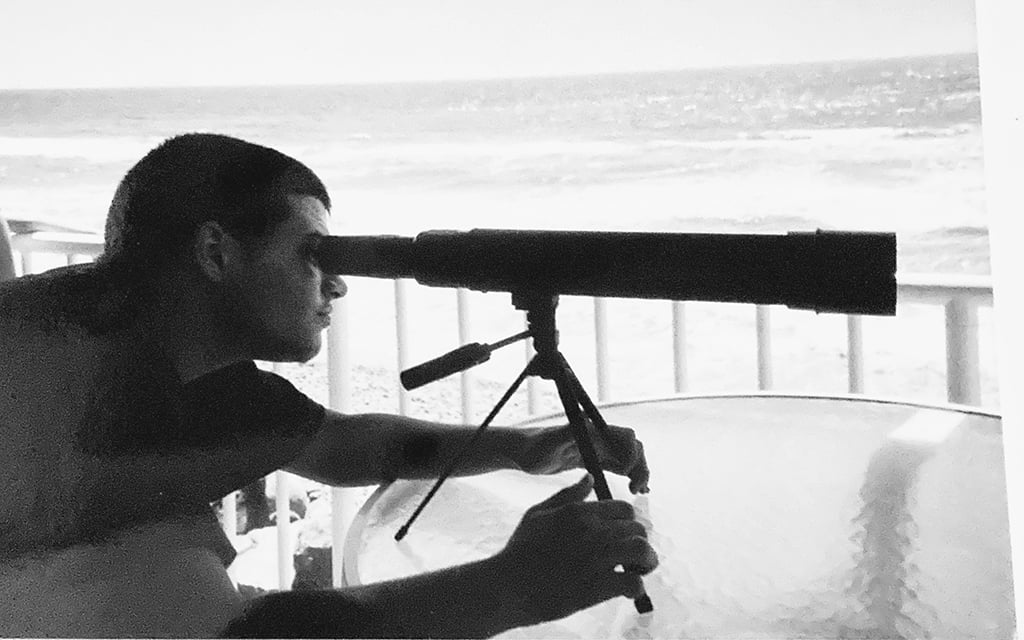
Adam Vespoli looks through a telescope in an old photograph. (Photo courtesy of Susan Vespoli)
It’s a stark depiction of how the absence of body-camera footage preserving a record of violent police encounters can rob loved ones of closure and obstruct efforts to hold officers accountable.
“Our argument was that Lindo felt that he could do whatever he wanted,” Burke said. “He knew that he didn’t have the body-worn camera.”
“My belief is he would have acted differently if it were on and he knew it was filming,” Burke said.
This story was produced by the students at the Howard Center for Investigative Journalism at Arizona State University’s Walter Cronkite School of Journalism and Mass Communication, an initiative of the Scripps Howard Foundation in honor of the late news industry executive and pioneer Roy W. Howard.